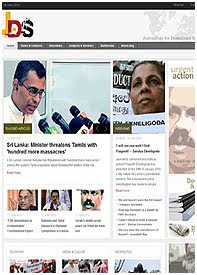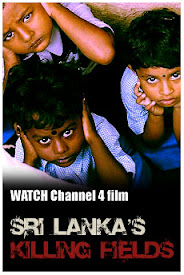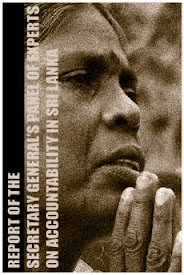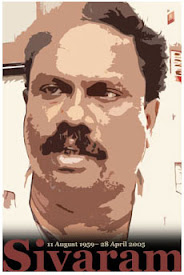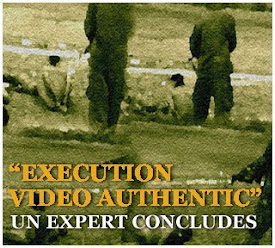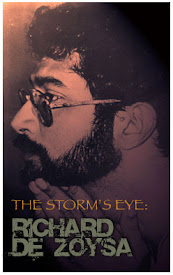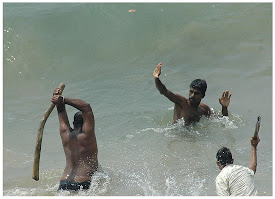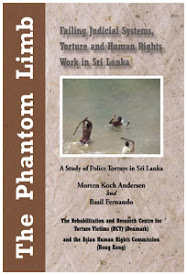
Channel 4
.............................................................................................................................................................................................
Sri Lanka's Killing Fields featured devastating new video evidence of war crimes and crimes against humanity - some of the most horrific footage Channel 4 has ever broadcast
Screened at the UN in Geneva and New York and also shown to politicians at the House of Commons, the European Parliament and key figures in the US Senate Sri Lanka's Killing Fields prompted comment from leading political figures around the world including Prime Minister David Cameron. Yet the Sri Lankan government has so far failed to fully investigate the horrific crimes featured in the film - including videos of extra-judicial executions, the aftermath of targeted shelling of civilian camps and evidence of sexual violence including the naked and abused bodies of female Tamil fighters - captured on mobile phones, both by Tamils under attack and government soldiers as ‘war trophies.'
For this new film, Sri Lanka's Killing Fields : War Crimes Unpunished (w/t), also presented by Jon Snow, director Callum Macrae has accumulated powerful new evidence including contemporaneous documents, eye-witness accounts, photographic stills and videos relating to how exactly events unfolded during the final days of the civil war. Jon Snow says: 'I'm very proud that the new year will see a follow up to our widely-acclaimed documentary Sri Lanka's Killing Fields. We believe it shows more evidence of official complicity in war crimes and we will continue to show what we find to the world. I hope this film captures, shocks and educates in the same way as the first did."
Despite pressure from human rights groups and the report by a UN-appointed panel of experts which called for a thorough international investigation into alleged violations of international humanitarian and human rights law, the Sri Lankan government's internal inquiry, ‘The Lessons Learnt and Reconciliation Commission' has so far failed to conduct any kind of rigorous investigation into the allegations of war crimes.
Sri Lanka's Killing Fields : War Crimes Unpunished (w/t) explores the reasons behind the apparent international inaction in calling the government of Sri Lanka to account. Byrne said: "The horrific revelations in Sri Lanka's Killing Fields caused concern across the globe and calls for further investigations so we decided to do just that; to continue the journalistic endeavour to find out the full truth about these terrible events."
Like Sri Lanka's Killing Fields, Channel 4 and ITN Productions will be making this second film available internationally - it will be ungeoblocked on 4oD. Chris Shaw is the executive producer and Callum Macrae is the director. Macrae said: "Just occasionally you get involved in a film which you feel might really make a difference. Our last film had an extraordinary international impact throughout the world. In this new film we investigate those responsible for those crimes; we show who knew about them and we explain just why the world failed to prevent them."
Sri Lanka's Killing Fields, has been watched by over a million viewers in the UK and been watched in over 30 countries on 4oD - totalling more than 455,000 across all platforms and more than 360,000 on channel4 4oD. It has also been televised in Australia, India, Denmark, Norway and Belgium.
© Channel 4
Wednesday, November 09, 2011
Channel 4 commissions second Sri Lanka war crimes investigation
Wednesday, November 09, 2011
Sri Lanka: Media watchdog appalled by web censorship
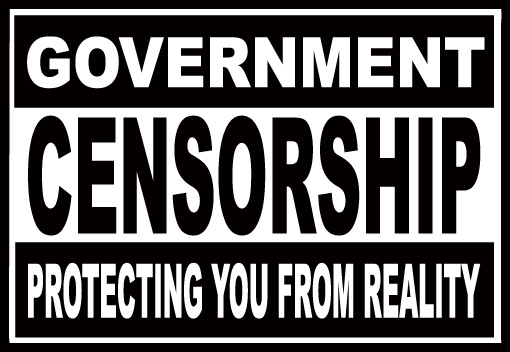
Reporters sans frontières (RSF)
.............................................................................................................................................................................................
“We deplore this measure, which reinforces government control over online media,” Reporters Without Borders said. “Several news sites had already been blocked by the government, and now this requirement to register with the information ministry poses an additional serious threat to the already limited online freedom of expression.
“We also condemn any attempt to control coverage of the ongoing ‘White Flag’ trial of former army commander Sarath Fonseka or to limit criticism of the government, no matter how virulent, for which journalists have been threatened. The information ministry must lift these blocking orders and rescind this new requirement. And we call on commercial telecom companies to stop blocking sites at the government’s behest.”
The announcement that news websites need to register with the media and information ministry and obtain accreditation came on 5 November, shortly after the secretary to the ministry, W.B. Ganegala, had accused certain websites earlier the same day of constantly defaming senior government officials.
It is not yet known how news websites are supposed to register or what sanctions they face if they refuse to comply. Some website journalists reportedly went to the ministry and requested registration forms only to discover that no procedures have so far been put in place.
The number of blocked sites has risen steadily in recent weeks. They include the Lanka-e-News site, which was blocked at the end of October by state-owned Sri Lanka Telecom (SLT) and privately-owned Internet service provider Dialog Axiata PLC without Lanka-e-News being given any explanation. Reporters Without Borders interviewed Lanka-e-News editor Sandaruwan Senadheera at the time (read the interview). The decision to block the site was upheld by a court today.
Sri Lanka is classified as a “country under surveillance” in the Reporters Without Borders report on “Enemies of the Internet” and is ranked 158th out of 178 countries in the Reporters Without Borders annual press freedom index.
© RSF
Wednesday, November 09, 2011
Sri Lanka abandons round-up of military deserters
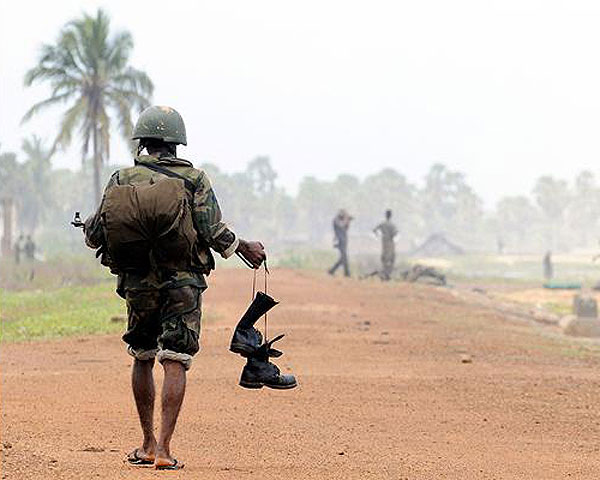
By Charles Haviland | BBC News
.............................................................................................................................................................................................
It says there are nearly 60,000 such deserters - an apparent increase of 10,000 in just under a year.
However, some of the deserters fled the forces many years ago.
A military spokesman said that the forces were now pursuing just a few dozen deserters who are thought to have committed serious crimes.
'Ex-soldiers'
Since it defeated the Tamil Tigers two-and-a-half years ago, Sri Lanka has not demobilised its soldiers.
Saying the country still faces a security threat, it has instead increased the size of the army to more than 200,000.
Clearly, however, not all within the forces are happy with their situation and desertions have continued on a large scale.
Just 12 days ago an army spokesman said that about 60,000 deserters would be rounded up and apprehended.
Now, however, he has told the BBC that nearly all of them will instead be de-listed and will be able to term themselves "ex-soldiers" rather than deserters.
There have continued to be many reports of deserters suspected of involvement in violent crime - most recently in the killing of a well-known doctor and in a separate triple-murder case.
While the army says it will pursue the few suspected of serious offences, it appears the military wants to de-link itself from any association with such criminality and also let non-criminal deserters get on with their lives.
© BBC News
Wednesday, November 09, 2011
Sri Lanka’s (nearly) forgotten massacre

By Jonathan Kay | National Post
.............................................................................................................................................................................................
Imagine that, sometime in the next few months, Hamas attacks against Israel escalate to the point of all-out war. Hundreds of Israeli tanks roll into Hamas-controlled territory, supported by artillery barrages and round-the-clock bombing runs. Position after position is overrun, until the retreating Arabs — Hamas fighters alongside innocent civilians — are packed into a tiny coastal sliver of beach. Fathers dig makeshift foxholes to protect their wives and children from Israeli bombs. Finally, Israeli forces penetrate the last defensive barrier, and kill Hamas’ leaders. Amid the battlefield carnage, tens of thousands of innocent civilians lie dead.
Imagine, for a moment, the international outcry that would accompany this bloodshed. It would be the Goldstone Report times a hundred. The daily massacres would be front-page news all over the world, every day. One can even imagine Turkey, Iran, Egypt, Syria and Hezbollah-controlled Lebanon joining the war and invading Israel.
Yet if you re-read the second paragraph of this column, and replace just three words — “Arab” with “Tamil,” “Hamas” with “Tiger,” and “Israel” with “Sri Lanka” — everything I described actually did happen in 2009, when Sri Lanka’s military overran Tamil Tiger forces in the northern part of that island nation. Yet, around the world, few paid these events any attention.
There was no “flotilla” for Sri Lankan Tamils: Most of the Canadian activists who rend their garments over the fate of Palestinians probably couldn’t find Sri Lanka on a map — even though the death toll in that country’s 26-year civil war was an order of magnitude greater than the combined death toll from Israel’s generations-long campaign against Palestinian terrorism.
This isn’t to say that the story in Sri Lanka was black-and-white. The Sri Lankan government had every right to fight the Tamil Tigers, which had mutated from a legitimate political movement into a nihilistic terrorist cult that assassinated leaders, kidnapped children for use as soldiers, staged suicide bombings, and even (through local proxies) extorted money from Tamil-Canadian shopkeepers. But the scope of the war got out of hand: In the last months, Sri Lankan forces effectively carpet-bombed swathes of territory that they had declared safe havens for civilians.
The word “massacre” is thrown around a lot in wartime. But in this case, there is solid evidence behind the charge. This is no Jenin-style pseudo-massacre we’re talking about.
Earlier this year, I sat down here in Toronto with a Tamil family that had witnessed all this firsthand, survived, and escaped to Canada.
The father — I’ll refer to him as B. — had worked in northern Sri Lanka as a photographer and Tamil activist. One day, he would be working a wedding. The next, he’d be taking photos of unexploded Sri Lankan bombs. His was an ordinary middle-class family, until everything turned to hell.
It was three years ago when the army moved into his area, declaring it a “high security zone.” He moved his wife and two young children to a village called Suthanthirapuram, where they lived in a makeshift hut.
But the war followed them there, too. In January 2009, bombs hit the local American Ceylon Mission, killing 17; and some of B.’s immediate neighbours were blown up by cluster bombs. He moved on to a nearby village, where his brother, a doctor, was living with his own family.
Then one day, Jan. 22, B. watched as his brother was blown apart as he stood at the mouth of a bunker they’d dug out together. Without time for a proper funeral, B. and his family took the body pieces in a rolled up sari and fled to the town of Puthukkudiyiruppu, as Sri Lankan soldiers flooded the area; and then on to the coastal area of Mathalan — a government-declared “no-fire zone” that became a killing field. By this time, B. and his family were down to one meal a day. The desperate struggle to stay one village ahead of the bombs turned the family into wandering vagabonds.
Finally, they ran out of real estate: B. and his family were trapped on a crowded beach — a stretch of sand a kilometre long and 300 metres wide, where the Tamil Tigers were making their last stand. Amid constant barrages, men dug desperately for cover in the sand, trying to create protective foxholes for their wives and children. When a bomb fell, B. saw figures go up in the air as people, and come down to the ground as corpses.
It’s been more than two years since all this happened. And Sri Lanka’s government would be more than happy to have all of it forgotten. But some world leaders have refused to succumb to amnesia — including our own PM and Foreign Affairs Minister. In September, John Baird declared that there were “credible” allegations of war crimes committed by Sri Lanka — and he continues to press the issue bilaterally with Colombo. More recently, Canada has threatened to boycott the 2013 Commonwealth summit in Sri Lanka unless its government takes responsibility for its behaviour toward the Tamil minority.
This is a positive step for Canada, which is home to the world’s largest Tamil diaspora. Under the Liberals, we swung too far in the opposite direction — refusing to list the Tamil Tigers as a terrorist group, and turning a blind eye to Tamil fundraising. Stephen Harper corrected that. And many observers credit Canada’s policies with a weakening of the Tiger military apparatus in the final years of the war. But standing firm against a terrorist group shouldn’t mean turning a blind eye to very real massacres against civilians.
Mr. Harper should keep holding the Sri Lankan government and military to account for what it did in 2009. Given the lack of international interest in this part of the world, our role here is important. If not for us, Sri Lanka may succeed in sweeping its actions under the carpet.
Jonathan Kay is Managing Editor for Comment at the National Post, and a fellow at the Foundation for Defense of Democracies in Washington, D.C.
© National Post
Wednesday, November 09, 2011
Sri Lanka sees "war tourism" as survivors struggle

By Nita Bhalla | Alertnet
.............................................................................................................................................................................................
Along the way, the buses stop and passengers descend into the hot afternoon sun, taking out their phones to photograph displays of blown-up water tanks, captured boats, armoured vehicles and monuments dedicated to the army. In some places, they buy a cool refreshment and a souvenir t-shirt.
More than two years after the Indian Ocean island's 25-year-old civil war ended, an entire generation of Sri Lankans is finally getting the opportunity to see a part of their country which was off limits. A place they had heard about, but never imagined visiting. A place now healing from the ravages of war.
"It’s really interesting to see all this," says accountant Gayan, 33, from the capital Colombo, as he holds up his BlackBerry to snap a picture of his brother and father posing in front of a captured truck. It’s on display at an army-run roadside "tourist spot" at Elephant Pass, a strategic military base fought over repeatedly during the 25-year civil war.
"Growing up, we would hear about the Tigers and were scared of attacks in Colombo, so it’s good to have peace and see the north," he said, sipping some ice-cold Coke at the cafe and examining the other war relics on display – a tractor and wooden boat once owned by the Tigers.
Sri Lanka’s army retook Elephant Pass, under Tiger control since 2000, as part of its 34-month offensive to end one of Asia’s longest modern conflicts once and for all – retaking nearly a third of the island’s land mass which the Tigers controlled, until a cataclysmic final battle defeated the separatists in May 2009.
In the nation’s south, including Colombo, the victory brought an end to the constant fear of suicide bombings and other attacks that killed thousands of civilians – a hallmark of the Tigers, who were on the terrorism lists of more than 30 nations.
Now, as communities return to find their homes destroyed, possessions lost and little means of making an income, some aid workers and residents question this “war tourism” in an environment where survivors worry about their next meal and are still haunted by their violent past.
"It’s wonderful that the war has ended," said a foreign aid worker based in the northern Kilinochchi district, who spoke on condition of anonymity for fear of upsetting the government.
"But given it was a horrible finish and that war-affected people are still struggling financially and emotionally to pick up the pieces and rebuild their lives, it’s too soon and insensitive to be making even a small business out of it or erecting memorials to those partly responsible for civilian deaths."
The government rejects allegations that it intentionally killed civilians during the final offensive, when some 300,000 were held hostage by the retreating Tigers.
It has ratcheted down the presence of foreign aid workers, especially in the north, where by necessity they worked with the separatists and often had their organisations infiltrated by Tiger operatives.
T-SHIRTS AND ARMY NOTEBOOKS
Most of the Tamil civilians were forced to flee with the Tigers, until army operations allowed hundreds of thousands of them to pour out. They were sent to crowded displacement camps lacking proper sanitation.
There is no conclusive figure on how many civilians were killed in the fighting in the final months.
A U.N.-sponsored report, criticised by the government as being filled with unfounded accusations that initially emerged from Tiger propaganda outlets, says there was "credible evidence" thousands and perhaps tens of thousands killed in shelling and fighting.
Yet no one who gets off the buses mentions the bloody end of the war or the struggle survivors are going through, despite the pick-up trucks laden with World Food Programme sacks of grain and large white lorries with the familiar blue "U.N." lettering – a telling sign that aid is still needed here.
Along the A9 Highway, which runs through the centre of Kilinochchi town, a massive concrete water tank lies fallen on its side, blown up by Tigers retreating from a place they unilaterally declared the capital of Tamil Eelam, the country they wanted to carve out as a Tamil-only preserve.
The destroyed tank is enclosed within a wall, together with a plaque and a "Souvenir Galore" shop run by the army. Visitors take a few snaps, have a cold drink and buy a black t-shirt or baseball cap with "Kilinochochi Re-awakening" emblazoned across it, or opt for the smart Sri Lanka military field notebooks on offer for a just few hundred Sri Lankan rupees.
"During the week, there are many buses and people stopping. At weekends, we get the most amount of visitors – around 600 or so," says Nalaka Vijaypala, 24, a Sri Lankan army soldier in civilian clothes, the left side of his head scarred from sniper fire during the war. "The army runs this place ... It’s popular."
Other monuments are also on display along the route – a giant cuboid with a bullet lodged inside it and a lotus flower and the gold, red and green Sri Lanka flag emerging from the top of it – in memory of the Sri Lankan army “in the gallant operation to annihilate savage and brutal terrorism which has terrified this land," reads the plaque.
The government has quickly repurposed its military assets and personnel for civilian purposes, in part to help President Mahinda Rajapaksa’s post-war development drive and also to keep the roughly 100,000 troops in the north gainfully engaged after the war.
But for some war survivors, it is just too early.
A few hundred metres down from the imposing cuboid, 35-year-old war widow Subendine, who sells vegetables by the roadside, says the visitors bring discomfort.
"They come and go ... they take their pictures. They don’t ask us or even want to know what happened," she said.
© Alertnet
Wednesday, November 09, 2011
EU concerned over Sri Lanka net censorship

Lanka Business Online
.............................................................................................................................................................................................
"The EU considers that freedom of press forms an integral part of any democratic system," European Union heads of mission said in a statement.
"The EU therefore believes that the media should be allowed to operate independently.
"The EU also believes that citizens have the right to access all information provided by the media and to make their own judgements and to formulate opinions independently.
"The EU Heads of Mission call on the Sri Lankan authorities to ensure that the rights of the free media are respected."
Sri Lanka's information ministry said several news websites were damaging the image of the country, head of state, minister and senior state officials. The ministry also wanted all websites carrying information about Sri Lanka to register with it.
The United States earlier expressed concern over the blocking of Lankaenews.com
© LBO
This site is best viewed with firefox

Search
Is this evidence of 'war crimes' in Sri Lanka?
Archive
- ► 2010 (1312)
- ▼ 2011 (687)
Links
- Reporters Sans Frontières
- Media Legal Defence Initiative
- International Press Institute
- International News Safety Institute
- International Media Support
- International Freedom of Expression eXchange
- International Federation of Journalists
- Committee to Protect Journalists
- Asian Human Rights Commission
- Amnesty International
